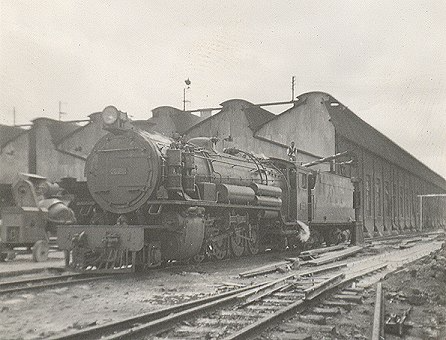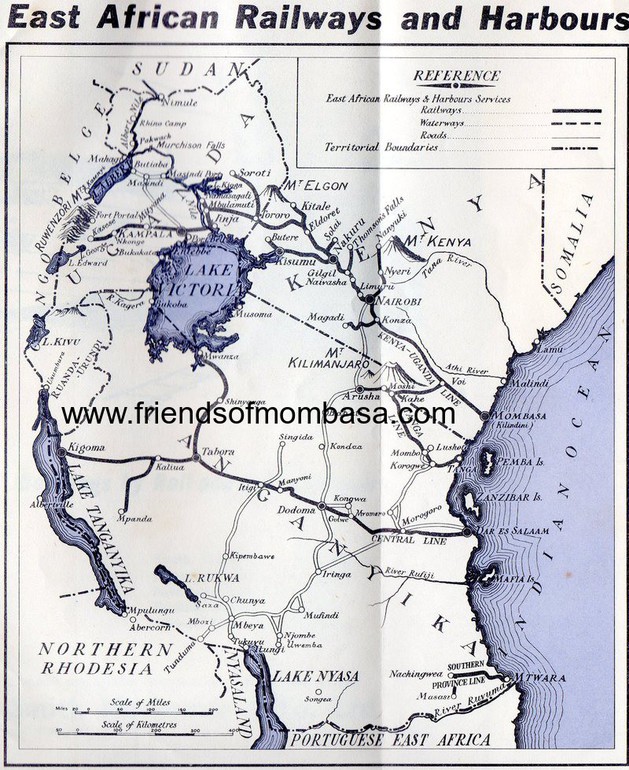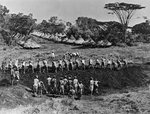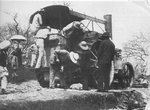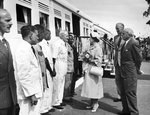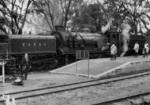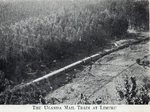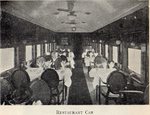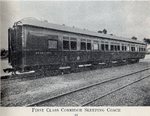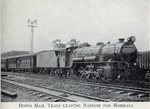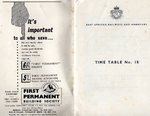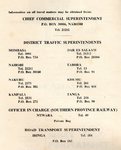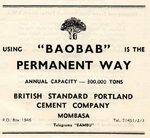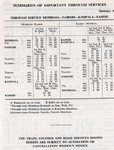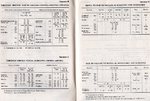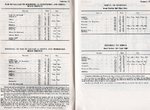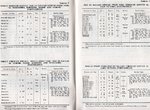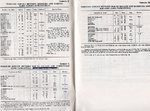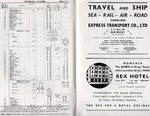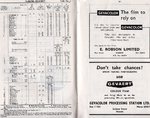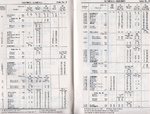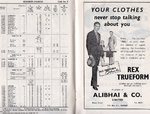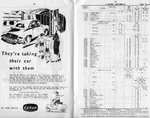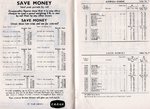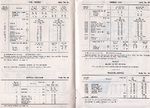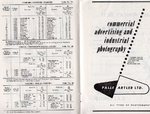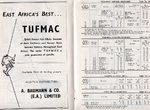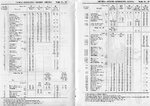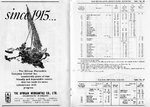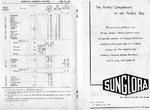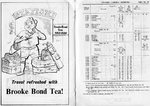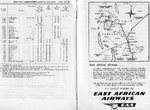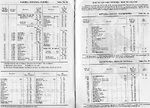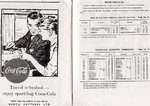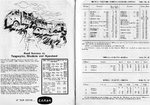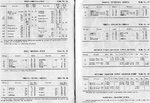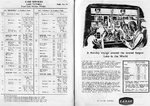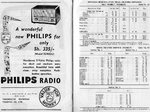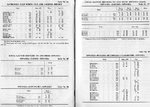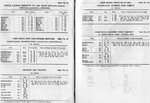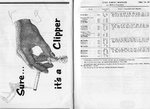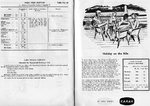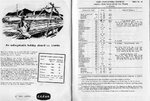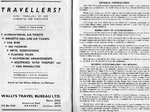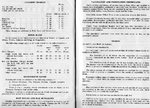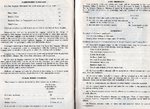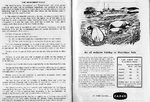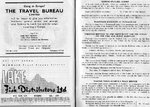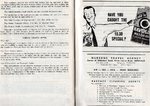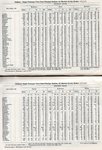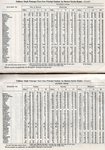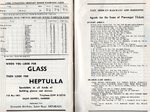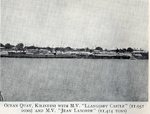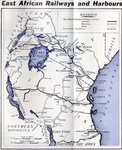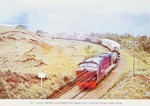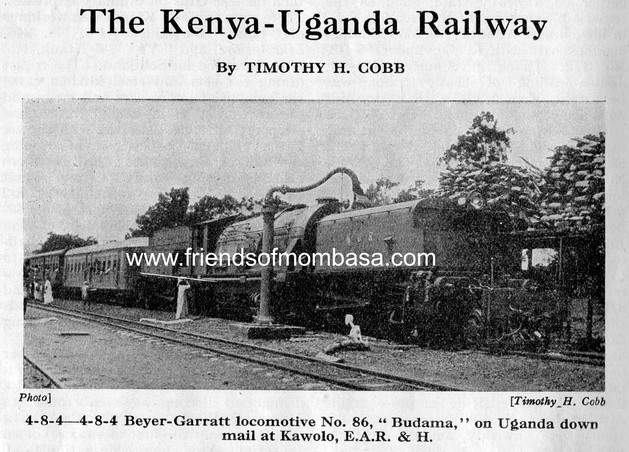East African Railways & Harbours
Click Below on Photo to Enlarge
The International Steam Pages (Early Types)
http://www.internationalsteam.co.uk/eastafrica/steam.htm
Garratts in East Africa
http://www.internationalsteam.co.uk/articulateds/garrattsafrica02.htm
The 28 Class were the largest non-articulated locomotives on the system. Here 2804 Kilifi is prepared for service at Nairobi Shed. Built by Messrs R Stevenson in 1928, they were originally designated the EA Class by the KUR&H. With their 4ft 3in driving wheels, these 2-8-2s looked far more like the locomotives built for the UK home market and looked distinctly un-African. - PHOTO Iain Mulligan
EAR & H Travel Schedule 1959
Weston Langford Railway Photography
Documenting railways and related infrastructure since 1960
http://www.westonlangford.com/images/photo/page/644/
Click on Photo below, to enlarge.
The Kenya-Uganda Railway
By TIMOTHY H. COBB
4-8-4—4-8-4 Beyer-Garratt locomotive No. 86, “ Budama,” on Uganda down
mail at Kawolo, E.A.R. & H.
AT 10 a.m. on Wednesdays and Saturdays the down Uganda Mail starts from Kampala on its 884-mile journey to the coast at Mombasa. In its course it crosses the Nile within a mile of its source, the highest railway summit in the British Empire, the equator three times, and diagonally the Eastern Rift Valley and up the eastern wall of it. From Nairobi it drops over 5,000 ft. to the sea in little more than 300 miles, and the whole journey takes just under 48 hours.
The Uganda Railway was begun on December 11, 1895, with construction on a few miles on Mombasa island and on the adjacent mainland. There was considerable scepticism as to whether the line would pay, but its avowed intention was to put an end to the slave trade. The work was done at high speed and survey parties were always busy on the next section ahead of the construction.
My 1899 the railhead had reached the I in I her edge of the Athi Plain at mile 315 and mid halted while the survey parties went ahead, and a supply base was established at the foot of the hills. This spot has becomeNairobi. Indians were imported to build the line to the metre gauge (which it still remains). The object of the builders was to push on to Uganda as quickly as possible; one result was that Kenya was “discovered "on the way.
After Nairobi the line climbed into the Kikuyu Hills and dropped down the escarpment into the Eastern Rift Valley. Such was the hurry to get the line open that the word “ dropped ” is almost literal; a temporary line was laid to overcome this descent of 1,552 ft. on gradients varying from 1 in 7 to 1 in 1.75. This section was worked by ropes, and for the steeper two parts a carrier was used for the trucks, as at Hownes Gill on the Stanhope & Tyne Railway in County Durham. The permanent line was brought into use in 1901, and the "lift” remains only a scar on the hill- face. North-west along and across the bottom of the valley construction was easy, but at Nakuru the line had to begin to surmount the Mau Plateau, over which it passes, with a summit of 8,322 ft. There are 27 steel trestle viaducts on this section, and the temporary Iine climbed down one side of the ravines on a gradient of 1 in 30, reversed and climbed out the other side on the same grade. From the summit the descent to the Lake is steeper, about 4,500 ft. in 80 miles. The first locomotive reached Port Florence (Kisumu) on Lake Victoria on December 20, 1901. Kisumu is 179 miles by water from Port Bell, which is 6 miles by rail from Kampala, the commercial capital of Uganda.
This land and water route remained the route to Uganda till the first half of the 1920s, when the all-rail route was completed, branching northwards from the Kisumu line at Nakuru and surmounting the Uasin Gishu Plateau near Timboroa, over the record summit of 9,136 ft. The line then descended into Uganda and joined the Busoga Railway, which was already in existence from Jinja to Namasagali, circumventing the rapids of the Nile. The junction, at Mbulamuti, about 30 miles north of Jinja, was reached in 1928. In 1931 the last section of the main line was opened, from Jinja to Kampala. The main engineering feature of this section is the single-span rail and road bridge over the Nile at Jinja, just below the Ripon Falls, where the Nile starts its 3,000-mile journey to the Mediterranean.
The Uganda Railway reached Tororo, the first station in Uganda, in 1927; just before it reached the objective that its name implied, it was renamed the Kenya & Uganda Railway, which it remained till May 1, 1948, when all the railway and steamship services in Kenya, Uganda and Tanganyika amalgamated to form the East African Railways & Harbours. These lines have always been state railways, though they are administered as a separate department.
A journey from Mombasa to Kampala is by no means dull. The mail train consists of about 13 carriages, three first, three second, three or four third, a restaurant car and two or three old first class non-corridor carriages used as seconds. This comes to about 400 tons tare. In addition there are two vans for crew and three or four covered freight trucks. From Mombasa the train is worked by a Mikado, built in 1927 by Robert Stephenson, Darlington, originally intended for shunting, but now used on most passenger trains between Mombasa and Nairohi. where the lines are 80 lb. to the yard, laid in 40 ft. lengths. The ruling grade from Mombasa to Nairobi is 1.18 per cent, in the up direction and 1.05 per cent, in the down, apart from the first few miles, where it is 2 per cent, to get clear of the coast. Up means up- country. All gradient posts are marked in percentages.
The line is single throughout, with passing loops at most of the stations, and water at intervals of some 20 miles. Signals guard the entrance to each loop, one above the other on the one post, the top indicating the left-hand loop, and the bottom the right. There is a daily service from Mombasa to Nairobi, and twice a week the trains runs right through to Kampala. The train leaves Mombasa at 4.30 p.m. and reaches Nairobi (315 miles) at 8.52 the next morning. First and second class carriages have side corridors, and the seats form sleeping berths at night, four to a compartment as the racks let down to form the upper berths.
There is practically no difference between first and second class, except that the former have a fan and bed- reading lamps, and are slightly less crowded. Third class carriages have wooden seats and centre corridors; they are always crammed to bursting point. Hire of bedding and food in the restaurant cars is cheap, and passengers are officially encouraged not to tip company’s servants—but they do. Speed is never high; the up mail train covers the first 30 miles out of Mombasa in 100 min., including two stops. All trains stop at all stations, with the exception of a few “local” stations near Mombasa and an odd flag stop or two usually missed by the mails.
Before it gets dark you can see the whole of Mombasa Island and Kilindini Harbour as the line clears the cocoanut groves and negotiates the first spiral into the hills. The first thing that strikes a stranger is the sharpness of the curves on the metre gauge ; it is not unusual for a long train to be travelling in three directions at once, and the engine is frequently in full view of the windows of the ninth or tenth carriage. After dark the train is a lighted snake, as, even when the passengers’ lights are out, each carriage has a side-light in the middle just under the eaves. The engine pierces a funnel in the darkness with its search-light. In the night are passed Mackinnon Road, the new military headquarters of growing importance; Voi, junction for Moshi on the slopes of Kilimanjaro, and the Tanga line (the only physical connection with the railways of Tanganyika) ; and Tsavo, famous for its man-eater lions which made havoc of the construction gangs.
You wake up next morning on what looks like Salisbury Plain, only here you climb up the side of every combe, round the end and out the other side. When I later saw this country from the air it looked quite flat and the railway seemed to be making an absurd fuss. At Nairobi the mail waits an hour-and- a-half. The station has three long platforms, mostly covered with awnings, the island connected with the main platform (which is used by the mails in both directions) by a subway. There is a complete set of signals, and it is the only station on the line which has the straight into the 1 in 50, which lasts for nearly 20 miles with few intermissions, and some pitches of 1 in 40. The scenery changes to woods of eucalyptus and intensive cultivation.
At lunch time, after a morning of heavy slogging, the train reaches Uplands, and suddenly, the Rift Valley is spread at your feet. Here a new alignment, the third in 50 years, was brought into use at the beginning of 1948, and the trees have not had time to grow high enough to obscure the view. The valley stretches as far as you can see, blue in the midday air of a station such as we know it in England. As at Marylebone, with luck one might see a train at any hour of the day. The mail endures some marshalling, and some coaches are added for the longer stage on to Kampala.
When I came up we started from Nairobi with thirteen large coaches and several smaller ones, vans and trucks on the back, a tare weight of 470 tons. We were headed by a 4-8-2 + 2-8-4 Beyer Garratt, and were banked by one of the shapely 4-8-0 tender engines which are the maids of all work. The line turns a sharp right-angle to the north to circumvent the town, and then plunges haze, and in the middle you look down into the crater of the extinct volcano Longonot. The railway winds down the face of the escarpment on a steady grade of 1.05 per cent., which is considerably better than the old route, up which trains took 2 hr. to struggle 15 miles, with two stops. In the floor of the valley the line passes hills of fantastic shape, like sleeping camels and inverted washbasins, and you can see the beautiful lakes Naivasha and Elementeita ; at Eburru jets of steam spurt out of the ground. There are all kinds of game in the valley, and you are unlucky if you do not see a giraffe or an ostrich, or at least a herd of buck. In the evening the train arrives at Nakuru; 120 miles in just under 8 hr.
After Nakuru the light remains only long enough to see the Lake Nakuru, away to the south, with its fringe of pink flamingos, and as the darkness falls the old main line to Kisumu branches to the left. The line to Uganda goes up the side of a slope in a series of S-bends and as the telegraph wires follow the line, from below they look like a forest as they thread backwards and forwards about six times. To see the next 125 miles to Eldoret, in some ways the most interesting of all, it is necessary to travel in a goods train which starts at dawn and arrives at dusk, taking just 12 hr. on the journey. The mail trains traverse this section in the night in both directions.
Some goods trains have a third class carriage at the back, and as the whole train is continuous-braked, travelling is not uncomfortable. Speed between stops is not much slower than the passenger trains, but crossing places may entail waits of over an hour, so heavily occupied is this section with goods trains during the day time. Soon the climbing starts in earnest, and the line is much on a shelf in wooded ravines, crossing side valleys on horseshoe embankments. From Maji Mazuri to Equator Station is over 20 miles, dreaded by enginemen for fear the water will run out; this stretch is over an hour’s collar work.
Below Equator station the line rises clear of the trees and the country is grassy and open, the scenery Alpine without the mountains or snow. An S-bend, and the lower of the two spirals is encountered. In the station the " line ” runs through the platform, at an altitude of 8,716 ft., 1,050 ft. above Maji Mazuri. The equator is crossed again, the second spiral is threaded, and the equator is crossed for the third and last time. Before the summit the line ploughs into wonderful cuttings and woods, and the absolute top is reached at 9,136 ft., and Timboroa station, 9,001 ft., is just beyond it. Because of these altitudes it was considered that the vacuum brake would not hold, so the Westinghouse is fitted.
The descent to Eldoret is quite different in scenery. First come bamboo forests, and a steel trestle over a ravine, then open countrv not unlike the moors between Riccarton Junction and Whit- rope summit on the Waverley route. At times you might think you were coming down Shap to the south, or crossing the blasted heath between Penruddock and Troutbeck. The kindlier country begins at Eldoret, where you are down to 6,000 again. Eldoret, a thriving centre of Kenya settlers, has the unfortunate distinction of having its two passenger trains a week in each direction in the station between 1 and 1.30 a.m. From Eldoret to Tororo I have not travelled by daylight, even in a goods train.
At Tororo the line enters Uganda. It is hotter and greener than Kenya, but, apart from the rocks of Tororo, reputed scene of Conan Doyle’s Lost World, the scenery as far as Jinja is dull. The line runs up and down small slopes, between elephant grass, sometimes as tall as 20 ft., bananas, coffee and cassava. At one place the Mpologoma swamp is crossed, an oasis of bright green papyrus, on a 2-mile embankment which gives continual trouble to the maintenance department. Near Jinja extensive sugar estates are passed. The wealthy Kampala dwellers cut this last bit out by having their cars to meet them at Nsinze, whence it takes about 3 hr. by road to get home ; the train, winding northwards through Busoga, and wandering back south with a touch of east, spends 7 hr. After Jinja, which is reached after lunch, the line twists and plunges down to cross the Nile. This is one of the highlights of the journey.
The bridge is in sight of the Ripon and the Owen Falls, and the line swings round and climbs till it passes just above the former. The clear blue of Lake Victoria and the broken white of the falls are not only a relief to the eye of the hot and dusty traveller, but here at your feet is the answer to the age-old riddle of where the Nile comes from ; this is its very source. One wonders if the Baganda and Basoga, who lived in mutual enmity on either side of it, ever used to ask themselves where the river went to. Opposite is the golf-course on which hippopotami form natural bunkers and are the rub of the green.
Buganda, entered on crossing the Nile, is a country of hills all the same height with flat tops, divided by swamps. The line was built more cheaply here, and there are manv short stretches of
2 per cent, uncompensated on the curves. The line rises and falls to cross almost every anthill. The downhill stretches lead to swamps which are crossed on embankments with right-angle bends, and as speed gathers you wonder what will happen at the bottom as you see the Beyer-Garratt swing round in full view of your window. About 10 years ago there was a terrible accident, and a crowded train plunged into a swamp. Over 20 passengers from the teeming third class carriages were pinned into the ooze and drowned.
Kampala, reached almost exactly 48 hr. after leaving Mombasa, is a single-platform station with a short bay at the eastern end. It is built at the top of a single line ramp of 2 per cent., and the yards are in the lower ground below. There is no turntable, but a triangle is laid out among the eucalyptus trees. The platform is covered most of its length, and the offices and station building are the best in the town. There are plans to extend the railway 200 miles farther west to Toro, on the slopes of Ruwenzori, which divides Uganda from the Belgian Congo. There are vast copper deposits there, but the proposed railway may be abandoned in favour of a canal, which will involve the deepening of a river whose flow is so sluggish that it is marked on maps as flowing both ways.
Some curiosities to end with: from Mbulamuti to Jinja the east-west main line runs distinctly eastwards for about 20 miles. The curves on the line have the inner edge of the outer rail oiled by hand twice a week. The two summits of 8,322 and 9,136 ft. on the Kisumu and Kampala lines respectively are only 20 miles apart, but on quite separate lines, yet they have each pursued an independent course of over 60 miles from their divergence at Nakuru. The main line from Nairobi to Uplands is being realigned, which will entail a completely new course for about 20 miles, and the complete abandonment of one station ; at one point a tunnel is being cut, which will rob the tunnel on the Kisumu line of its uniqueness in East Africa. ^ The only racial discrimination on the railway is against Europeans, as they are not issued with tickets below second class, even for trains which consist of third class carriages only.
RMS Victoria one of the Luxurious ships that sailed on Lake Victoria By Odhiambo Levin Opiyo
RMS Victoria one of the Luxurious ships that sailed on Lake Victoria
By Odhiambo Levin Opiyo
In July 22nd 1961 history was made in Kisumu a town on the shores of Lake Victoria when Lady Renison the wife of Governor Renison commissioned RMS Victoria ,the largest ship ever built for service on Lake Victoria.
During the ceremony the ship was first blessed by KE Stovold the Archdeacon of Kisumu before Lady Renison named the ship and broke a bottle of champagne on the bow.
Then to the strains of “Life on the Ocean wave “ march by the kenya police band ,Lady Renison her husband Governor Renison ,the Governors of Uganda and Tanganyika and ministers from the three territories were piped aboard.
Later in the brilliant sunshine with her flag streaming in the breeze Victoria sailed out of Kisumu on her inaugural voyage.
RMS Victoria was designed primarily for the carriage of passengers but provision was also made for the carriage of some 5000 cubic feet of refrigerated cargo.
When the contract for the new ship was placed consideration was given to a name for her and with the agreement of the three East African Governor the name Victoria was selected.
In september 1958 her Majesty Queen Elizabeth the Queen of Engalnd graciously gave her consent to the use of prefix “Royal Mail Ship” RMS to the ship since it was also going to be used for carriage of her mails.
The inland marine services on Lake Victoria can be traced back to 1890 when as a result of the Brussels conference the world powers decided that the building of Railways and the establishments of ships on the inland waters was the most effective means for counteracting the slave trade in the interior of Africa.
The first ship to operate on Lake Victoria was the “Kenya” built in Glasgow in 1890.






















